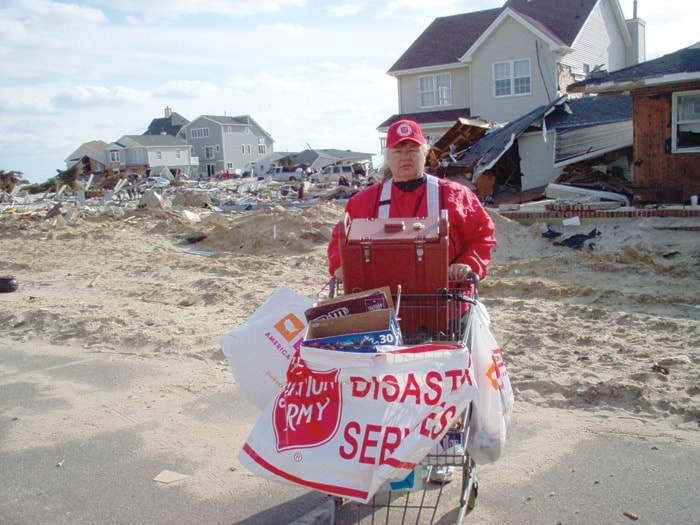Mass destruction. Devastation. Homes levelled.
A Campbell River emergency and disaster response volunteer thought her training would ensure no surprises, but nothing could prepare her for what she saw in the aftermath of Hurricane Sandy which swept through the Caribbean and eastern United States last October.
“I had been to Texas (after Hurricane Ike devastated Galveston in 2008) so I was prepared for the piles of garbage but Ortley Beach (New Jersey) was mass destruction. Whole neighbourhoods were gone,” said Joanne Hart, a volunteer with the Salvation Army’s disaster support team and an Emergency Disaster Service Representative with the Strathcona Regional District’s Emergency Social Services.
Hart spent two weeks (Nov.22 - Dec.6) in hurricane-ravaged New Jersey, in an area hit particularly hard known as Barrier Island.
Working with a team from the Salvation Army, Hart provided emotional support to victims of the disaster in all of the little townships along the island – Ortley Beach, Lavallette, Monterey Beach, and Chadwick Island.
Conditions on the island were so poor, that the entire island was closed throughout the evening and overnight hours. The bridge over to the island would open each day at 8 a.m. and by 3 p.m. every resident of Barrier Island, as well as volunteers and constructions crews, had to vacate the island in order to prevent looting.
During the day, Hart was tasked with pushing a cart through the sand covered streets, offering coffee, hot chocolate and snacks to locals desperately trying to clean out their homes.
The sand, dumped inland by the high ocean tides as the hurricane made landfall, made a difficult task even harder for the homeowners.
“The people I was assisting, a lot of them literally were clearing out their houses and having to take them down to their studs,” Hart said. “Ceramics and glassware could be saved but everything else had to be gutted – all the wood furniture, cloth, clothing, they had to pile it in front of their houses.”
Hart said some houses were completely gone while others were still standing and appeared to be saved but in reality, the foundation had shifted and the house was slated to be taken down.
Hart said one of the residents told her they had lost nearly 20 feet of the Jersey shoreline. The sand brought in was so thick that the streets had to be ploughed and local residents had to shovel the sand out just to get to their homes.
Hart said the hardest part for the residents was seeing pieces of their homes taken away.
“Crews would go in with heavy equipment at night (while the island was closed) and each day you would see the garbage piles growing and growing,” Hart said. “Everyone had to drive past those mountains to get to their homes so they might see some of their furniture.”
Hart said everyone living on Barrier Island was either living in a shelter or had been put up in a hotel by FEMA (Federal Emergency Management Agency) or by their insurance.
Many of the evacuees were staying in the same hotel as the Salvation Army team in a nearby town, Toms River, and Hart and her team were able to offer emotional support sessions in the hallways. Hart also visited with the victims at mobile kitchens set up along the streets and at FEMA locations, where the evacuees could go to fill out paperwork for emergency assistance.
Hart said the resilience of the people who lived through the disaster was amazing.
“I met lots of incredible people and I was reminded of the resiliency of people,” Hart said.
Hart met one family who was planning their Fourth of July party for this year, despite losing everything except the front stoop of their home. Hart said the woman is determined to sit out on her tiny front stoop even though the rest of her home is gone.
During her first week of deployment, Hart met another woman who asked if Hart could come by her home and deliver a coffee to her husband who was working inside. The woman told Hart that her husband survived stage four rectal cancer but now has cancer in his liver and lungs and was working really hard to clean up their home.
Hart said the woman’s story “rocked me to my core”. She said despite the ordeal, the couple were surrounded by their family who were cheerful and laughing and enjoying their hot chocolate.
“I spent quite a while with her and then headed back,” Hart said. “Tears were streaming down my face and a lady flagged me over to get a coffee. I told her it was the wind that made my eyes water.”
Hart said there were similar “God moments” all around her team, from meeting a persevering man who had been flooded out months earlier up state from Hurricane Irene only to lose everything once again to Hurricane Sandy to offering a coffee to a woman who was so grateful she broke down and cried.
Still, Hart said she feels as if she’s the one who benefited.
“It seems selfish but I feel like I got more out of it by going there than the people I helped did,” Hart said.
Hart will be presenting her experience to the regional district’s Emergency Social Services team on Jan. 21 at 7 p.m. in the Search and Rescue building on Larwood Road, behind the Willow Point Fire Hall.
